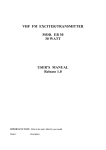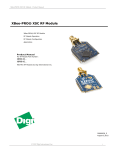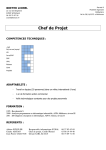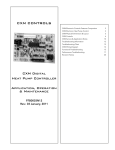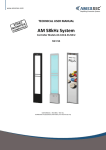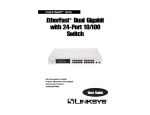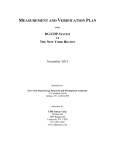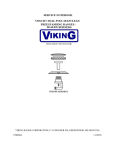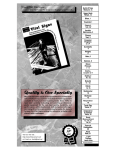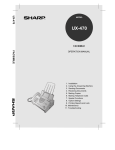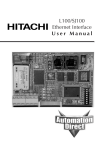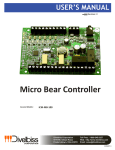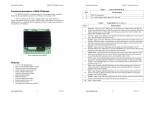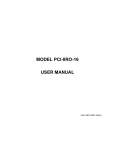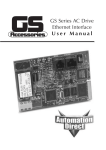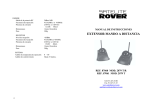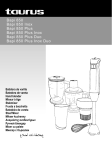Download Wireless Temp and/or Humidity System Instructions
Transcript
Wireless Temperature and/or Humidity System Installation and Operating Instructions rev. 04/21/15 27986_Wireless_System_Ins Wireless System Overview 418 MHz System: The Transmitter measures the temperature or temp/ humidity and transmits the data at 418MHz to the 418 MHz Receiver up to 100 feet away. The optional temperature setpoint and override status are also transmitted at 418 MHz to the receiver. The transmit rate is about once every 20 seconds with an estimated battery life of 5 to 8 years. The information sent by the Transmitter is picked up by the 418 MHz Receiver and passed along to the Analog Output Modules. Each transmitted variable (temperature, humidity, setpoint, etc.) is converted by a separate output module into an analog resistance, voltage, current or relay contact which is hard wired to the analog inputs of the BAS controller. Analog Output Modules Converts the Temperature, Humidity, Setpoint and Override Info into an analog resistance, voltage, current or relay for the BAS controller 418 MHz Up to 100 Feet Transmitter Transmits the Temp, Humidity, Setpoint and Override Info Fig. 1: 418 MHz Wireless System 418 MHz Receiver Receives the Temperature, Humidity, Setpoint and Override Info from the Transmitter and passes it on to the Analog Output Modules 900 MHz System: The Transmitter measures Analog Output Modules the room temperature or Converts the Temperature, temp/humidity and transHumidity, Setpoint and mits the data at 418MHz Override Info into an analog to a Repeater up to 100 resistance, voltage, current feet away. The optional or relay for the BAS controller temperature setpoint and override status are also 900 MHz 418 MHz transmitted at 418 MHz to Up to 1,000 Up to 100 the Repeater. The transmit Feet Feet rate is approximately once Transmitter every 20 seconds with an Transmits the estimated battery life of 5 Temperature, 900 MHz Receiver to 8 years. Humidity, Receives the Temperature, Humidity, Setpoint Repeater Setpoint and and Override Info from the Repeater and The 418 MHz information Receives the 418 MHz Override Info passes it on to the Analog Output Modules sent by the Transmitter is Info from the Transmitter and Re-Transmits it at 900 picked up by the Repeater Fig. 2: 900 MHz Wireless System MHz up to 1,000 feet and then Re-Transmitted at 900 MHz to a 900 MHz Receiver up to 1,000 feet away. The 900 MHz receiver picks up the information from the repeater and then passes it along to the Analog Output Modules. Each transmitted variable (temperature, humidity, etc.) is converted by a separate output module into an analog resistance, voltage, current or relay contact which is hard wired to the analog inputs of the BAS controller. Wireless Temperature and/or Humidity Transmitters Room Temperature or Temp/Humidity Sensor Outside Air Temperature Sensor Duct Temperature Sensor Outside Air Temp/Humidity Sensor Duct Temp/Humidity Sensor Remote Temperature Sensor Immersion Temperature Sensor Specifications subject to change without notice. Building Automation Products, Inc., 750 North Royal Avenue, Gays Mills, WI 54631 USA Tel:+1-608-735-4800 • Fax+1-608-735-4804 • E-mail:[email protected] • Web:www.bapihvac.com 1 of 8 Wireless Temperature and/or Humidity System Installation and Operating Instructions rev. 04/21/15 27986_Wireless_System_Ins Analog Output Module Training The installation process requires that each transmitter is trained to its associated output modules so that they communicate with each other. Pushing buttons in a defined sequence on the units will bind them together. The training process is easiest on a test bench with the units within arm’s reach of each other. Training can be done in the field but requires two people and a set of walkie talkies or cell phones. Be sure to place an identification mark on the transmitter and associated output modules after they have been trained so that they can be matched together at the job site. Battery polarity is important or damage to the unit may occur Override Button If more than one variable is transmitted by the transmitter (temperature, humidity and setpoint for instance), each variable requires a separate output module. Perform the training sequence for each output module. Any transmitted variable can be trained to more than one output module. If a Repeater is used in the system, be sure it is powered and within reception range of the transmitter and the 900 MHz Receiver to train the output modules. Setpoint Slider TEMPERATURE OR HUMIDITY VARIABLE TRAINING 1. To train an output module to a temperature or humidity variable, select the Resistance, Voltage or Current Output Module calibrated to the proper temperature or humidity range and connect it to the wireless receiver. Note: Multiple output modules can be trained to the same transmitter variable if desired. 2. Apply power to the receiver which will supply power to the connected output modules. The power LED on the receiver will light and remain lit. (Current Output Modules must have loop power supplied to the module itself before they can be trained.) 3. Remove the cover of the room transmitter and remove the battery tabs or install the batteries, observing polarity as shown in Fig 3. Or open the cover of the BAPI-Box on nonroom transmitters and remove the battery tabs or install the batteries as shown in Fig 4. The “transmit LED” will flash about once every 20 seconds, indicating a transmission. (The flash is very quick.) Training Button Transmit LED Fig. 3: Room Transmitter battery installation and training Training Button Transmit LED Battery Connectors Transmitter Module Fig. 4: Non-Room Transmitter battery installation and training. (Duct Temp/ Humidity Transmitter is shown but the process is similar for all nonroom transmitters.) 4. Press and hold down the “Service Button” on the top of the output module (Fig 5) that you wish to train. Then, press and release the “training button” (see Fig 3 & Fig 4) on the transmitter. When the output module receives the “training transmission” from the transmitter, the output module’s red LED will light steady. Release the “Service Button” on the output module and the red LED will go out. The transmitter and output module are now trained to each other. During normal operation, the output module’s LED will flash about once every 20 seconds indicating data reception from the transmitter trained to it. Note: Combination transmitters send both the temperature and humidity information when the “Training Button” is pressed. However, each Analog Output Module is configured at the time of order as a temperature, humidity, setpoint or override module and will only recognize the relevant information and will ignore the rest. 5. Mount the transmitter at the desired location, removing the batteries if needed. (The units will remain trained to one another through power failures and battery replacement.) SETPOINT VARIABLE TRAINING Battery polarity is important or damage to the unit may occur. Output Module Service Button Fig. 5: Output Module 1. To train an output module to a Setpoint variable, select the Setpoint Output Module (SOM) calibrated to the proper setpoint range and connect it to the wireless receiver. Note: Multiple output modules can be trained to the same transmitter variable if desired. 2. Apply power to the receiver which will supply power to the connected output modules. The LED on the Receiver will light and remain lit. 3. Remove the cover of the room transmitter and remove the battery tabs or install the batteries, observing polarity as shown in Fig 3. The “transmit LED” will flash about once every 20 seconds, indicating a transmission. (The flash is very quick.) 4. Press and hold down the “Service Button” on the top of the output module (Fig 5). Then, press and release the OVERRIDE button on the transmitter (See Fig 3). (Note: If the unit was not ordered with an override function, then the OVERRIDE button will be shorter and will not extend outside the case but will still be accessible upon removing the cover.) When the output module receives the “Training Setpoint” info from the transmitter, the output module’s red LED will light. Release the “Service Button” on the output Continued on next page.... Specifications subject to change without notice. Building Automation Products, Inc., 750 North Royal Avenue, Gays Mills, WI 54631 USA Tel:+1-608-735-4800 • Fax+1-608-735-4804 • E-mail:[email protected] • Web:www.bapihvac.com 2 of 8 Wireless Temperature and/or Humidity System Installation and Operating Instructions rev. 04/21/15 27986_Wireless_System_Ins Analog Output Module Training continued.... module and the red LED will go out. The transmitter and output module are now trained to each other. During normal operation, the output module’s LED will flash about once every 20 seconds indicating data reception from the transmitter trained to it. 5. Mount the transmitter at the desired location, removing the batteries if needed. (The units will remain trained to one another through power failures and battery replacement.) OVERRIDE TRAINING - OVERRIDE IN PARALLEL WITH THE TEMP VARIABLE 1. An Override function can be added to a Resistance Output Module or Voltage Output Module that has been previously trained to the Temperature variable. (Current Output Modules cannot be used with the override function.) Select the previously trained output module that will have the override function. Remove the cover by squeezing the top and bottom or using a flat screwdriver as shown in Fig 6. Place the module’s jumper J4 in the “Override Training ON” position as shown in Fig 7. Squeeze 2. Apply power to the receiver which will supply power to the connected output modules. The power LED on the Receiver will light and remain lit. 3. Remove the room transmitter cover and remove the battery tabs or install the batteries, observing polarity as shown in Fig 3. The “transmit LED” will flash about once every 20 seconds, indicating a transmission. (The flash is very quick.) Squeeze 4. Press and hold down the “Service Button” on the top of the output module (or on the circuit board if the cover is removed, see Fig 7). Then, press and release the OVERRIDE button on the room transmitter (See. Fig 3). When the output module receives the “Training Override” info from the transmitter, the output module’s red LED will light. Release the “Service Button” on the output module and the red LED will go out. This module is now trained to the override function on the room transmitter. 5. Return the jumper on J4 to the “Override Training OFF” position (Fig 7) and replace the output module’s cover. Pressing the override on the room transmitter will cause the Resistance Output Module output to go to less than 100 Ohms for 5 seconds or the Voltage Output Module output to go to 0 Volts for 5 seconds. 6. To remove the override function, retrain the module to the temperature variable (pg 2). This removes the override function. 7. Mount the transmitter at the desired location, removing the batteries if needed. (The units will remain trained to one another through power failures and battery replacement.) J4 Override Training Off Fig. 6: Cover Removal Squeeze top and bottom or use a flat screwdriver. J4 Override Training On “Service Button” with Cover Off Fig. 7: Override Training Jumper Positions (J4) and “Service Button” OVERRIDE TRAINING - OVERRIDE IN PARALLEL WITH THE HUMIDITY VARIABLE 1. An Override function can be added to a Voltage Output Module that has been previously trained to the Humidity variable. (Current Output Modules cannot be used with the override function.) 2. Apply power to the receiver which will supply power to the connected output modules. The power LED on the Receiver will light steady. 3. Remove the room transmitter cover and remove the battery tabs or install the batteries, observing polarity as shown in Fig 3. The small LED at the bottom right of the circuit board, next to the setpoint, will flash approximately once every 20 seconds indicating a transmission. (The flash is very quick.) 4. Press and hold down the “Service Button” on the top of the Voltage Output Module. Then, press and release the OVERRIDE button on the room transmitter (See. Fig 3). When the output module receives the “Training Override” info from the room transmitter, the output module’s red LED will light. Release the “Service Button” on the output module and the red LED will go out. This output module is now trained to the override function on the room transmitter Pressing the override button on the room transmitter will cause the Voltage Output Module output to go to 0 Volts for 5 seconds. 5. To remove the override function, retrain the module to the humidity variable. This removes the override function. 6. Mount the transmitter at the desired location, removing the batteries if needed. (The units will remain trained to one another through power failures and battery replacement.) OVERRIDE TRAINING - OVERRIDE AS A SEPARATE OUTPUT WITH A RELAY OUTPUT MODULE (RYOM MODEL ONLY) 1. To train a Relay Output Module (RYOM model only) to the Override function, connect the output module to the receiver. 2. Apply power to the receiver which will supply power to the connected output modules. The power LED on the Receiver will light and remain lit. 3. Remove the room transmitter cover and remove the battery tabs or install the batteries, observing polarity as shown in Fig 3. The small LED at the bottom right of the circuit board, next to the setpoint (see Fig 3), will flash approximately once every 20 seconds indicating a transmission. (The flash is very quick.) Continued on next page.... Specifications subject to change without notice. Building Automation Products, Inc., 750 North Royal Avenue, Gays Mills, WI 54631 USA Tel:+1-608-735-4800 • Fax+1-608-735-4804 • E-mail:[email protected] • Web:www.bapihvac.com 3 of 8 Wireless Temperature and/or Humidity System Installation and Operating Instructions rev. 04/21/15 27986_Wireless_System_Ins Analog Output Module Training continued.... 4. Press and hold down the “Service Button” on the Relay Output Module (Fig 5). Then, press and release the OVERRIDE button on the room transmitter. When the output module receives the “Training Override” info from the room transmitter, the output module’s red LED will light. Release the “Service Button” on the output module and the red LED will go out. This Relay Output Module is now trained to the override function on the room transmitter. 5. Pressing the override button on the room transmitter will cause the output of a “Momentary” Relay Output Module to switch states for 5 seconds — the output of a “normally open” version will go to closed for 5 seconds, the output of a “normally closed” version will go to open for 5 seconds. 6. Mount the transmitter at the desired location, removing the batteries if needed. (The units will remain trained to one another through power failures and battery replacement.) Mounting of the Room Transmitter Note: The transmitter should have been trained to the output module at this point of the installation. Provided Drywall Anchors Provided #6 x 1” Screws 3.25” (80mm) Fig. 8: Drywall Mounting Drywall Mounting 1. Place the base plate against the wall where you want to mount the sensor. Typically 5 feet above the floor. 2. Using a pencil, mark out the two mounting holes. 3. Drill two 3/16” (4.7 mm) holes in the center of each marked mounting hole. Insert a drywall anchor into each hole. 4. Secure the base to the drywall anchors using the #6 x 1” mounting screws provided. 5. Install provided batteries or pull battery tabs and follow polarity as shown in figure 3 or damage may occur. The unit will work on just one battery however the battery life will be cut in half. 6. Attach cover by latching it to the top of the base, rotating the cover down and snapping it into place. 7. Secure the cover by backing out the lock-down screws using a 1/16” Allen wrench until they are flush with the bottom of the cover. Note: Mounting of Non-Room Transmitters is covered in the individual installation and Operation documents for that unit. Go to the specific wireless transmitter product on the BAPI website (www.bapihvac.com) and click on the “documents” tab. Mounting and Locating of the Antennas on the 418 MHz Receiver, 900 MHz Receiver and the Repeater The 418 MHz Receiver, 900 MHz Receiver and Repeater may be located inside a metal enclosure but their antennas must be outside the enclosure. The 418 MHz Receiver comes with a 418 MHz Dipole Antenna. The 900 MHz Receiver comes standard with a 900 MHz “Whip” Antenna but is available with a 900 MHz Dipole Antenna. The Repeater comes standard with a 418 MHz Dipole Antenna and a 900 MHz “Whip” Antenna, but is available with a 900 MHz Dipole Antenna. To mount the 418 MHz Dipole Antenna or 900 MHz Dipole Antenna, peal off the protective film from the adhesive pad and stick the antenna to a wall or other non-metallic support so that antenna is vertical for best reception. Antenna’s should be mounted as far away from metal plates or bars as possible to avoid RF energy being reflected back or blocked on the other side of the metal. An antenna will not work inside a metal box. Mounting to drywall between studs, ceiling tiles, brick, or concrete is very common. Transmission distance performance will vary based on environment. 100 feet is the maximum that can be expected if there are no obstructions. In general, each obstruction will half the expected transmission distance. Obstructions include but are not limited to; walls, partitions, floors, ceilings, doors, tinted glass, ground, many people, vehicles, foliage, rain, snow and fog. Metal (solid or screen) blocks the RF signal preventing propagation but also can bounce the signal around the potential obstacle. Wood, drywall, plaster, brick, and concrete attenuates the signal but will let it pass (if it’s not too thick) at a reduced signal strength. Anything that holds water absorbs the signal to the point of blockage like rain, fog, people, ground, dense foliage etc. Elevator shafts and stairwells usually block RF signals. 900 MHz The 900 MHz “Whip” Antenna simply screws “Whip” onto the 900 MHz Receiver or the Repeater. Antenna 900 MHz 418 MHz Mounting the antenna on a metal surface may Dipole Dipole limit reception from behind the surface. Antenna Antenna For more information on mounting antennas, see the BAPI docs “18709_ins_418_433_ antenna.pdf” and “19858_ins_900_MHz_ antenna.pdf” which are available on the BAPI Note: The Dipole antennas above are displayed horizontally to show website at www.bapihvac.com. dimensions but they should be mounted vertically for best reception. Specifications subject to change without notice. Building Automation Products, Inc., 750 North Royal Avenue, Gays Mills, WI 54631 USA Tel:+1-608-735-4800 • Fax+1-608-735-4804 • E-mail:[email protected] • Web:www.bapihvac.com 4 of 8 Wireless Temperature and/or Humidity System Installation and Operating Instructions rev. 04/21/15 27986_Wireless_System_Ins Mounting of the 418 MHz Receiver, 900 MHz Receiver, Repeater and Analog Output Modules The 418 MHz Receiver, 900 MHz Receiver, Repeater and Analog Output Modules can be mounted in snap track, DIN Rail or surface mounted. The text and figures in this section refer to the 418 MHz Receiver, but the mounting process is the same for the 900 MHz Receiver and the Repeater (although there are no Analog Output Modules connected to the Repeater). Fig. 9: Receiver and output modules mounted in snaptrack. SNAPTRACK MOUNTING Push in the blue mounting tabs on the bottom of the receiver and output modules. These units will now fit into the board slots of 2.75” snap track. Insert the receiver at the far left of the snap track, then insert each analog output module and slide it to the left until its connectors are fully mated into the receiver or the next analog output module. You may attach up to 127 analog output modules to a receiver. If your output modules cannot fit in one piece of snap track, then mount another piece of snap track nearby and insert the additional modules. Connect wires from the right side of the first string of modules to the left side of the second string of modules on the second snap track. (See “Extending the RS485 Network...” on pg. 7.) This configuration requires one or more Pluggable Terminal Block Connector Kits (BA/AOM-CONN) for the extra wire terminations on the left and right side of the Analog Output Modules. Each kit includes 4 connectors for the left and right connections. DIN RAIL MOUNTING Push out the blue mounting tabs on the bottom of the receiver and output modules. These units will now snap onto DIN Rail. Catch the EZ mount hook on the edge of the DIN rail as shown in Fig 11. Then rotate into place. Fig. 10: Receiver and output modules mounted on DIN Rail. Fig. 11: Catch the EZ Mount hook on the edge of the DIN Rail, then rotate into place. Attach the receiver at the far left of the DIN Rail, then attach each analog output module and slide it to the left until its connectors are fully mated into the receiver or the next analog output module. You may attach up to 127 analog output modules to a receiver. If your output modules cannot fit onto one piece of DIN Rail, then mount another piece nearby and attach your additional modules. Connect wires from the right side of the first string of modules to the left side of the second string of modules on the second DIN Rail. This configuration requires one or more Pluggable Terminal Block Connector Kits (BA/AOM-CONN) for the extra wire terminations on the left and right side of the Analog Output Modules. Each kit includes 4 connectors for the left and right connections. SURFACE MOUNTING Push out the blue mounting tabs on the bottom of the receiver and output modules. Attach the receiver to the surface by inserting a screw in each blue tab. Attach Analog Output Modules by placing each one against the surface and sliding it to the left until its connectors are fully mated into the receiver or the next analog output module. Attach each module to the surface with two screws, one in each blue tab. You may attach up to 127 analog output modules to a receiver. Fig. 12: Receiver and output modules surface mounted. If your output modules cannot fit in one straight line on the surface, then mount a second string of modules nearby. Connect wires from the right side of the first string of modules to the left side of the second string of modules. (See “Extending the RS485 Network...” on pg. 7.) This configuration requires one or more Pluggable Terminal Block Connector Kits (BA/AOM-CONN) for the extra terminations on the left and right side of the Analog Output Modules. Each kit includes 4 connectors for the left and right connections FCC Approval and Compliance FCC Approval #: T4F061213RSO (418MHz Room Transmitter Only) • T4F060811TEMP (418MHz Temperature Probe Only) T4F060811RH (418MHz Temp & Humidity Probe Only) • MCQ-XBPS3B (Repeater Unit Only) Compliance: This device complies with Part 15 of the FCC rules Operation is subject to the following conditions. 1. This device may not cause harmful interference. 2. This device must accept any interference received, including interference that may cause undesired operation. FCC Radio Frequency Interference Statement: This equipment has been tested and found to comply with the limits for a Class B digital device, pursuant to Part 15, Subpart B, of the FCC Rules. This equipment generates, uses, and can radiate radio frequency energy. If not installed and used in accordance with the instructions, it may cause interference to radio communications. Specifications subject to change without notice. Building Automation Products, Inc., 750 North Royal Avenue, Gays Mills, WI 54631 USA Tel:+1-608-735-4800 • Fax+1-608-735-4804 • E-mail:[email protected] • Web:www.bapihvac.com 5 of 8 Wireless Temperature and/or Humidity System Installation and Operating Instructions rev. 04/21/15 27986_Wireless_System_Ins 418 MHz Receiver and 900 MHz Receiver with Analog Output Modules Termination 418 MHz System 418 MHz Receiver System Power Supply 9 to 30VDC or 17 to 31VAC Power for the Power Bus can be supplied to the receiver or to the Analog Output Module on the far right of the string of modules, but not to both places. The Power Bus must be connected to the controller “-” power terminal. Resistance Output Module Voltage Output Module The Resistive Thermistor Temp. Signal is Polarity Sensitive to the Controller and Must Have Less than a 5VDC Bias Voltage. Both “+” and “-” must be connected to the controller signal input and the negative “-” connected to the power supply negative “-” Current Output Module Requires loop power before it can be trained. 0 to 5VDC or 0 to 10VDC Analog Signal Relay RS-485 Bus Output Module To Other Analog Output Modules Current Loop Power Supply 9 to 36VDC 4 to 20mA Current Loop Signal to the Controller Solid State Relay 40 VAC/VDC Max 150 mA Max 1 uA Leakage Max Fig 13: 418 MHz Receiver and Output Module System Wiring Termination Notes for 418 MHz and 900 MHz Systems: 1. The wireless receiver and Analog Output Modules are interconnected and require module power along the “Power Bus” terminals. The bus can be powered from either the receiver end on the left or the last output module on the right side. Be sure you have enough DC current or AC VA for all the devices on the bus. 2. The Current Output Module (BA/COM) signal is LOOP POWERED and must be externally powered with 9 to 36 VDC separate from the Power Bus. The Loop Power must be connected to the Current Output Module before it can be trained. 3. Be sure to follow the polarity (+ or –) symbols listed on each receiver and the output modules to maintain communication and Power Bus integrity. 900 MHz System 900 MHz Receiver System Power Supply 9 to 15VDC Power for the Power Bus can be supplied to the receiver or to the Analog Output Module on the far right of the string of modules, but not to both places. The Power Bus must be connected to the controller “-” power terminal. Resistance Output Module Voltage Output Module The Resistive Thermistor Temp. Signal is Polarity Sensitive to the Controller and Must Have Less than a 5VDC Bias Voltage. Both “+” and “-” must be connected to the controller signal input and the negative “-” connected to the power supply negative “-” Current Output Module Requires loop power before it can be trained. 0 to 5VDC or 0 to 10VDC Analog Signal Relay RS-485 Bus Output Module To Other Analog Output Modules Current Loop Power Supply 9 to 36VDC 4 to 20mA Current Loop Signal to the Controller Solid State Relay 40 VAC/VDC Max 150 mA Max 1 uA Leakage Max Fig. 14: 900 MHz Receiver and Output Module System Wiring Specifications subject to change without notice. Building Automation Products, Inc., 750 North Royal Avenue, Gays Mills, WI 54631 USA Tel:+1-608-735-4800 • Fax+1-608-735-4804 • E-mail:[email protected] • Web:www.bapihvac.com 6 of 8 Wireless Temperature and/or Humidity System Installation and Operating Instructions rev. 04/21/15 27986_Wireless_System_Ins Extending the RS485 Network between the Receiver and the Analog Output Modules The Analog Output Modules may be mounted up to 4,000 feet away from the Receiver. The total length of all the shielded, twisted pair (TSP) cables shown in Fig. 15 is 4,000 feet (1,220 meters), and “T” taps are not allowed. Connect the terminals as shown in Fig. 15. BAPI’s VC350A EZ Voltage Converter and a small transformer can be used to power the group of Analog Output Modules. *If the distance from the receiver to the group of Analog Output Modules is greater than 100 feet (30 meters), provide a separate power supply for that group of Modules and install a 120Ω load resistor (1/4 watt) across the “+” and “-” communication terminals. 120Ω load resistor (1/4 watt) across the “+” and “-” communication terminals. See Asterisk (*) above. Pluggable Terminal Block Kit (BA/AOM-CONN) RS485 TSP Wiring RS485 TSP Wiring Y 120Ω* Note: This configuration requires one or more Pluggable Terminal Block Kits for the extra wire terminations on the left and right side of the Analog Output Modules. Each kit includes 4 connectors. Receiver Analog Output Modules Analog Output Modules BAPI VC350A EZ Voltage Converter BAPI VC350A EZ Voltage Converter BAPI VC350A EZ Voltage Converter Transformer Transformer Transformer Fig. 15: Extended RS485 Network between the Receiver and the Analog Output Modules Specifications WIRELESS TRANSMITTER SPECS WIRELESS 418MHZ & 900 MHZ RECEIVER SPECS Supply Power: Two AA 3.6V Lith. batteries, 2.25 AH 5 to 8 year battery life at 20 second transmit rate Supply Power: 418 MHz Unit: 9 to 30 VDC or 17 to 31 VAC 900 MHz Unit: 9 to 15 VDC Potential Inputs: Temperature - Thermistor • Relative Humidity – Capacitive Setpoint – Potentiometer • Override – SPST switch Accuracy: ±0.54°F (±0.3°C) / ±2% RH Transmitted Range: -40 to 185°F (-40 to 85°C ) • 0 to 100% RH Antenna: Built inside the enclosure Power Consumption: 80 mA max. DC, .5 VA max AC Inputs: 418MHz or 900 MHz (depending on model) Input Sensitivity: -112db Output Signal: RS485 Proprietary Indicators: Red Power LED, blinks during reception Dimensions: Shown at the bottom of page 1 Antenna: 418 MHz Unit: 418 MHz Dipole with 79” Cable 900 MHz Unit: 900 MHz Whip or 900 MHz Dipole w/ 79” Cable Environmental Operation Range: Temp: 32° to 140°F (0° to 60°C) Humidity: 5% to 95% RH non-condensing Enclosure Material & Rating: ABS Plastic, UL94 V-0 Radio Frequency: 418 MHz North America Typical Reception: 418 MHz Unit: Up to 100 feet in building, line of sight 900 MHz Unit: Up to 1,000 feet in building Bus Cable Distance: 4,000 ft with shielded, twisted pair cable (Belden 9841, Belden 8132 or equivalent) Transmitter Interval: ~20 seconds WIRELESS REPEATER SPECS Supply Power: 9 to 15 VDC Power Consumption: 150 mA max. DC Input and Output: 418 MHz Input, 900 MHz Output Dimensions: 3.32” W x 2.87” L x 1.28”H (84.3 x 98.2 x 32.5mm) Environmental Operation Range: Temp: 32 to 140°F (0 to 60°C) Humidity: 5% to 95% RH non-condensing Enclosure Material & Rating: ABS Plastic, UL94 V-0 Output Modules per Receiver: Any mix of up to 127 Overall Dimensions: 3.32” W x 2.87” L x 1.28”H (84.3 x 98.2 x 32.5mm) Environmental Operation Range: Temp: 32°F to 140°F (0°C to 60°C) Humidity: 5% to 95% RH non-condensing Enclosure Material and Rating: ABS Plastic, UL94, V-0 Specifications subject to change without notice. Building Automation Products, Inc., 750 North Royal Avenue, Gays Mills, WI 54631 USA Tel:+1-608-735-4800 • Fax+1-608-735-4804 • E-mail:[email protected] • Web:www.bapihvac.com 7 of 8 Wireless Temperature and/or Humidity System Installation and Operating Instructions rev. 04/21/15 27986_Wireless_System_Ins Analog Output Module Specifications All Analog Output Modules: Overall Dimensions: 2.5”H x 2”W x 1.25”D, (63.5 x 49 x 31.7mm) Enclosure Material & Rating: ABS Plastic, UL94 V-0 Resistance Output Module (ROM): Resolution: ~0.5ºF ROM-102: 35 to 120ºF (1 to 50ºC), 10K-2 Thermistor Curve ROM-103: 32 to 120ºF (0 to 50ºC), 10K-3 Thermistor Curve ROM-10311: 32 to 120ºF (0 to 50ºC), 10K-3 (11K) Therm. Curve ROM-20: 53 to 120ºF (12 to 50ºC), 20K Thermistor Curve Power Consumption: 11.9 mA max. DC, .36 VA max AC Thermistor Bias: Less than 5 VDC max Output Resolution: 10 bit Voltage Output Module (VOM): Output Voltage Range: 0 to 5 volts or 0 to 10 Volts Output Current: 1 mA Power Consumption: 11.9 mA max. DC, .36 VA max AC Output Resolution: 10 bit Setpoint Output Module (SOM): Setpoint Output Ranges: See data sheet Power Consumption: 11.9 mA max. DC, .36 VA max AC Output Resolution: 10 bit Current Output Module (COM): External Loop Power Required: 9 to 36VDC at 25mA min Output Current Range: 4 to 20 mA (factory calibrated) Supply Bus Power: Not used by module just feeds through Output Resolution: 12 bit Note: Loop must be powered to train the output module. Relay Output Module (RYOM Only): Relay Output: 40V (DC or AC peak), 150 mA max. Off state leakage current 1 uA max. On state resistance 15Ω max. 5 second momentary actuation Note: Full device specifications are on the individual Analog Output Module installation/operation sheets. Wireless System Diagnostics Possible Problems: Temperature or Humidity is reading its low limit or high limit, or the LED at the top of the Analog Output Module is blinking rapidly: Possible Solutions: - Check for proper wiring and connections from the output modules to the controller. - Check to see if the controller’s software is configured properly. - Check for proper power to the receiver, repeater (if used) and output modules. - Check that the associated transmitter is transmitting (the LED will flash about once every 20 seconds when it transmits). If not, replace the batteries. Check that the associated receiver is receiving the tranmissions (its LED will blink right after the transmitter LED if it receives that transmission.) If it is not receiving the transmissions, move it closer to the transmitter or reposition the antenna for maximum reception. Note: The receiver will receive transmissions from all transmitters that are within range, not just the one you are testing. - Retrain the Analog Output Module. Temperature or Humidity reading is coming out the wrong output module - Retrain the Analog Output Module. Temperature or Humidity reading is incorrect - Check for proper wiring and connections from the output modules to the controller. - Check to see if the controller’s software is configured properly. - Check to see if the correct output module is connected to the correct controller. Default Status when wireless transmission is interrupted: If an output module does not receive data from its assigned transmitter for 15 minutes, the red LED on the top of the module will blink rapidly. If this happens, the individual Analog Output Modules will react as follows: • Resistance Output Modules (BA/ROM) calibrated for temperature will output the highest resistance in their output range. • Voltage Output Modules (BA/VOM) calibrated for temperature will set their output to 0 volts. • Current Output Modules (BA/COM) calibrated for temperature will set their output to 4 mA. • Voltage Output Modules (BA/VOM) calibrated for humidity will set their output to their highest voltage (5 or 10 volts). • Current Output Modules (BA/COM) calibrated for humidity will set their output to 20 mA. • Setpoint Output Modules (BA/SOM) will hold their last value indefinitely. • Relay Output Modules (BA/RYOM Units Only) will go to their default state (example: open for a normally open unit). When a transmission is received, the output modules will revert to normal operation in 60 seconds or less. Specifications subject to change without notice. Building Automation Products, Inc., 750 North Royal Avenue, Gays Mills, WI 54631 USA Tel:+1-608-735-4800 • Fax+1-608-735-4804 • E-mail:[email protected] • Web:www.bapihvac.com 8 of 8








